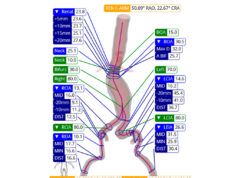 A review of intraoperative adverse events in patients treated with fenestrated and branched endovascular aneurysm repair, meta-analysis findings on peripheral arterial disease symptoms in men vs. women, and an interview with Palma Shaw (Syracuse, USA) caught readers’ attention in March.
A review of intraoperative adverse events in patients treated with fenestrated and branched endovascular aneurysm repair, meta-analysis findings on peripheral arterial disease symptoms in men vs. women, and an interview with Palma Shaw (Syracuse, USA) caught readers’ attention in March.
1. S.M.A.R.T. Radianz vascular stent system approved for transradial use in the USA
Cordis recently announced that the US Food and Drug Administration (FDA) has approved the S.M.A.R.T. Radianz vascular stent system, a self-expanding stent purposefully engineered for radial peripheral procedures.
2. F/BEVAR review reveals less than 20% of patients suffered intraoperative adverse event
A retrospective evaluation of 600 fenestrated or branched endovascular aneurysm repairs (F/BEVARs) for the treatment of complex aneurysms revealed that fewer than one in five patients experienced an intraoperative adverse event, according to a press release announcing study results published in the March 2022 edition of the Journal of Vascular Surgery.
3. Peripheral arterial disease symptoms differ between sexes, meta-analysis finds
In future peripheral arterial disease (PAD) research, clinicians should not consider men and women as a single population and should instead report their data separately. This is the main conclusion of a systematic review and meta-analysis recently published in the European Journal of Vascular and Endovascular Surgery (EJVES), which found that symptoms of lower leg PAD present differently between men and women.
4. InspireMD announces the inclusion of its CGuard carotid stent in CREST-2 trial
InspireMD has announced that its CGuard embolic prevention stent system (EPS) will be included as a device option for stenting in CREST-2 (Carotid revascularisation endarterectomy or stenting trial). Following the recent approval of the CREST-2 investigational device exemption (IDE) supplement application from the US Food and Drug Administration (FDA), the company states that it will be evaluating strategic sites to enable expediated access.
The US Food and Drug Administration (FDA) recently announced it has issued a letter to healthcare providers emphasising the importance of lifelong surveillance, including imaging, for patients with abdominal aortic aneurysm (AAA) endovascular aneurysm repair (EVAR).
6. Viabahn use in claudicants with long, complex SFA lesions “safe and effective” through five years
Recently published research indicates that stent grafting with the Viabahn endoprosthesis (W L Gore & Associates) of long and complex superficial femoral artery (SFA) lesions in patients with claudication is a safe and effective long-term treatment option.
“As vascular surgeons, we never stop learning,” Palma Shaw tells Vascular News. This is one of the key attractions of the specialty for Shaw, who recalls various aspects of her career to date—from her early days learning endovascular surgery from Frank Veith to impacting the learning of others and addressing disparities in education across the globe in her role as secretary general of the World Federation of Vascular Societies (WFVS).
Johns Hopkins Medicine researchers have developed and tested a new imaging approach they say will accelerate imaging-based research in the lab by allowing investigators to capture images of blood vessels at different spatial scales.
9. Medtronic expands reach of AI-powered surgical video management and analytics platform
Medtronic has announced that it has entered into a contract with Vizient to add Touch Surgery Enterprise, an AI-powered surgical video management and analytics platform for the operating room (OR), to Vizient’s offerings.
10. PROMISE II US pivotal trial of device designed for “no-option” CLTI patients completes enrolment
Enrolment has been completed in the PROMISE II pivotal trial of the LimFlow deep vein arterialisation system (LimFlow SA) designed to prevent amputations in so-called “no-option” chronic limb-threatening ischemia (CLTI) patients, the eponymous device maker announced.













